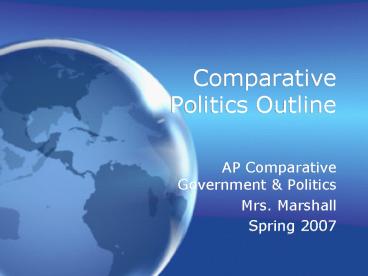Comparative Politics Outline - PowerPoint PPT Presentation
1 / 20
Title:
Comparative Politics Outline
Description:
Parliamentary or presidential systems. Authoritarian regimes. Decisions made by political elites ... Competitive elections. Liberal democracies (v. illiberal ... – PowerPoint PPT presentation
Number of Views:72
Avg rating:3.0/5.0
Title: Comparative Politics Outline
1
Comparative Politics Outline
- AP Comparative Government Politics
- Mrs. Marshall
- Spring 2007
2
1 The Comparative Method
- Three world approach
- Advanced democracies
- Communist post-communist countries
- Less developed (LDCs) and NICs
- Impact of informal politics
- Importance of political change
- Integration of political and economic systems
- Never study countries by themselves!
3
2 Sovereignty, Authority, Power
- Sovereignty ability to carry out action or
policies within their borders independently from
interference either from the inside or the
outside - States
- organization that maintains a monopoly of
violence over a territory - Max Weber - Institutions
- Stable, long lasting organizations that help to
turn political ideas into policy
4
Max Webers State
5
2 S, A, P
- States, nations regimes
- Democracies
- Direct or indirect
- Parliamentary or presidential systems
- Authoritarian regimes
- Decisions made by political elites
- Some based on communism
- Corporatism patron-client systems
6
2 Legitimacy - What makes A,S, P work
- Traditional legitimacy
- Tradition should determine who should rule and
how - Charismatic legitimacy
- Based on the dynamic personality of an individual
or small group - Rational-legal legitimacy
- Based on a system of well-established laws and
procedures - Rule of law
- Most modern states rely on this form!
7
2 Political Culture Ideologies - What makes
up A,S, P
- Political culture political beliefs, values,
practices, institutions government is based on - Political ideologies sets of political values
held by individuals regarding the basic goals of
government politics
8
2 A, S, P - Common Political Ideologies
- Liberalism
- Conservativism
- Communism
- Socialism
- Fascism
- Religions
9
3 Political and Economic Change
- Types of Change
- 1. Reform
- Change methods, not substance (no overthrow
advocacy!) - 2. Revolution
- Advocates change at more basic level
- More widespread
- 3. Coup detats
- Most limited
- Replaces leadership, but undirected - usually
overthrown by another coup
10
3 Attitudes Toward Change
- Radicalism
- Rapid, systemic change necessary
- Liberalism
- Reform gradual change (not liberal ideology!)
- Conservatism
- Change is disruptive brings unforeseen
consequences - Reactionary beliefs
- Turn back the clock (even status quo is bad)
11
3 Three Trends
- Democratization
- Competitive elections
- Liberal democracies (v. illiberal democracies)
- Civil liberties
- Rule of law
- Neutrality of the judiciary
- Open civil society
- Civilian control of the military
12
3 More(surfs up!)
- Third wave of democratization
- 1st wave gradual
- 2nd wave post WWII
- Why democratize?
- Loss of legitimacy
- Expansion of urban middle class
- Human rights emphasis
- snowball effect (end of Cold War)
13
3 Oh Yeah Those Trends
- 2. Movement toward Market Economies
- Terms command economies, market economy, mixed
economy, marketization, privatization - 3. Revival of Ethnic or Cultural Politics
- Terms fragmentation, nationalism, politicization
of religion
14
4 Citizens, Society, State
- Social cleavages
- Citizen/state relationships
- Attitudes beliefs of citizens
- Political socialization
- Voting behavior
- Factors that influence political beliefs
behaviors
15
More 4
- Civil society
- Def organizations outside the state that help
people define and advance their own interests - Political institutions
- Levels of government
- Confederal, federal, and unitary
16
5 Political Institutions
- Political institutions
- Levels of government
- Confederal, federal, and unitary
17
Even more 5
- Supranational organizations
- NATO, EU, UN, etc.
- Executives
- Head of state v. head of government
- Bureaucracies
- Remember Weber!
- Legislatures
- Judiciaries
- Linkage institutions
18
Last 5
- Electoral systems
- First-past-the-post
- Single-member districts (v. multi)
- Plurality system
- Winner-take-all
- Proportional representation
- Mixed system
- Political elites/recruitment
19
6 Public Policy
- Created by legislative vote, executive decision,
judicial rulings, or a combo of all three - Many issues similar in all countries, but
governments differ in how they approach issues
and what importance they assign to them
20
6 Public Policy
- Economic performance
- Domestic issues and international trade
- Social welfare
- Health, employment, family assistance, eduction
- Civil liberties, rights, freedoms
- Freedom House
- Environment































